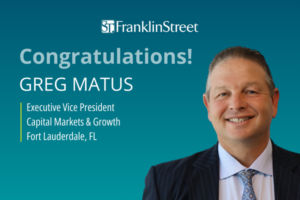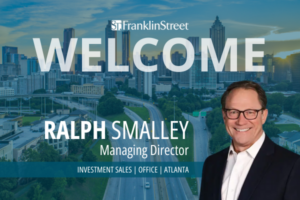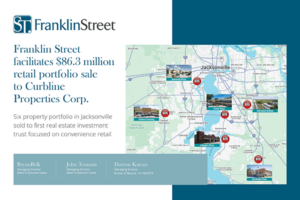More cashing out, More competition, More compression on cap rates. Those are a few of the ways the net lease market has changed since this time last year. Foreign investors are making their mark, build-to-suit is back in vogue and new challenges are emerging that could change market dynamics in the months ahead.
The net lease retail market entered 2015 on mixed footing. Low oil prices are hampering earnings at gas stations and extra income in consumers’ pockets is being redirected to other purchases, according to Marcus & Millichap’s Net-Leased Retail Research Report. The firm predicted investors executing 1031 exchanges will dominate the net lease market in 2015 as retiring Baby Boomers take advantage of record-low cap rates in the apartment market.
David Sobelman, executive vice president and managing partner at Calkain Cos., a Reston, VA-headquartered brokerage firm specializing in triple net leases investments, has his ear to the ground. He hears from a diverse swath of practitioners in various disciplines throughout the net lease investment industry – and the general consensus is there’s a severe lack of supply in today’s market. But he’s not seeing exactly the same thing he’s hearing.
“Our tracking of the market is proving otherwise,” Sobelman says. “There is actually a healthy supply of net lease investments in today’s market. But there is a severe lack of supply of quality net lease properties. Inventory is high overall, but low from a quality perspective.”
Compromising Quality?
The lack of supply of quality net lease properties isn’t stopping the deal flow. James McCartney, managing director at Net Lease Capital Advisors, a net lease acquisitions, advisory and brokerage firm in Nashua, NH, says investors are digging deeper to make deals happen.
“There are more deals getting done in secondary and tertiary markets and lower credit deals in the search for yield,” McCartney says. “Demand continues to exceed supply. We’re seeing bidding wars on corporate headquarter buildings and ground leases.”
Net lease investors may be venturing into secondary and tertiary markets and eyeing class B and class C assets, but thtat doesn’t necessarily mean they are compromising the quality of the actual investment criteria. Jason Fox, head of global investments at W. P. Carey, a global net lease REIT, says the same investment criteria apply across the net lease board.
“For a credit tenant with a long lease, where the majority of the projected return comes from rental payments versus residual value, secondary and tertiary markets can provide attractive investment opportunities,’ Fox says. “It is a question of evaluating risk-adjusted returns where the lease term, creditworthiness of the tenant and criticality of the asset all play a role in the investment decision whether it be class A, B or C assets.”
From Sobelman’s perspective, investors are getting more creative all the time. Indeed, they are increasingly willing to concede on different aspects of their investment strategy in order to purchase properties that fit their return thresholds. Secondary and tertiary markets are part of those concessions.
“I remember in 2005 and 2006, when there was a drastic increase in new housing developments and supporting from an infrastructure perspective, net lease properties were ‘in the path of growth,'” Sobelman says. “The same phenomenon applies to today’s market as construction and investment is occurring outside of core markets.”
Foreign Investors Make Their Mark
Foreign investment into US commercial real estate continues in 2015. According to the Association of Froreign Investors in Real Estate’s 2015 survey, over 90% of respondents plan to maintain or increase the size of their US portfolios in 2015 – and the US was voted the most stable and secure country for investment, with the best opportunity for capital appreciation by a wide margin.
“As it periodically has been in the past, the United State is current the target of much of the foreign investment in real estate globally,” says Thomas Arnold, AFIRE chairman and head of Americas real estate at the Abu Dhabi Investment Authority. “With a stable and transparent market and an economy that appears to be steadily imporving without the fits and starts expedrienced in other regions, the US has become the first stop for foreign real estate investors. And with the continued creation of wealth in China, it is not surprising that they, along with other nationalities, are voting with their ‘dollars.'”
Industry players say net lease properties are a beneficiary of the foreign investment trend. WPC’s Fox reports foreign investors will actively pursuing net-leased assets, either independently or though American partners and advisors despite the rising strength of the US dollar. Jon Graber, a director at Franklin Street, says he’s seeing the most interest from syndicators and private buyers from South America: “We have handled the successful sale of several triple net assets from investors in Argentina and Brazil but have also sold property to groups from Canada and Europe as well. Foreign investors look at opportunities differently than domestic investors and see the US as a safe haven for the capital.”
Meanwhile, Marcus & Millichap commercial real estate broker Alex Zylberglait, who specializes in the sale of Miami properties ranging from $1 million to $20 million, says the starting point for private foreign investors is often net-leased assets: “Many of them do have a preference for single-tenant net-leased properties, especially when they are just getting into the US markets as they generally don’t require much in terms of management. In addition, they like the perceived safety of investment grade tenants on long-term leases.”
What about the rising strength of the US dollar? Even though returns may be higher in their home countries, foreign investors are still choosing to invest within the borders of the United States, according to Sobelman. “Like any macroeconomic adjustment there will be a period of pause and reflection, but it’s clear that US real estate, and specifically the US net lease investment market, is the most stable in the world,” he says. “That will not go unnoticed, regardless of where the investor originates.”
How Big Is the Build-to-Suit Trend?
As retailers face pressure from Wall Street to increase revenue, the only way to grow is by increasing their store counts. During the recession, Rafeal Wright, an investment sales associate as Franklin Street, reminds that retailers looked at business models and ways to decrease costs.
“Retailers most were relatively successful through the reduction in operating expenses and renegotiation of existing leases,” Wright says. “With a stronger economy, coupled with surging population growth in Florida, retailers are actively looking to add stores or reposition existing stores into better locations.”
Fox says build-to-suit is a growing trend in Europe. WPC recently closed a $115-million build-to-suit transaction for the Rabobank headquarters in Eindhoven, the Netherlands with Dutch developer OVG Group. The construction is expected to be completed in the first quarter of 2017. “We have also seen build-to-suit as a component of existing asset acquisitions,” he says. “For example in 2014 we acquired and then funded the expansion of a distribution center for Belk in Jonesville, SC.”
On the other sie of the transaction table, Calkain represents developers around the country that specialize in build-to-suit net lease assets. Sobelman says build-to-suit development has made a strong return because tenants are much more comfortable building a new location for themselves today then they were five years ago.
“However, the tenants that are having the most success with build-to-suit properties are those that started their due diligence two or more years ago,” he explains. “New tenants coming to the market today are having a tough time finding new locations that fit their business models and, subsequently, the developers that partner with the tenants are experiencing the same challenges.”
Finding (and Creating) Net Lease Opportunities
Finding net lease acquisition opportunities doesn’t look the same for the small private investor as it does for the large REIT – but there are opportunities at both end of the spectrum in today’s market. For WPC, the biggest opportunities lie in more complex transactions rather than commoditized offerings that attract multiple investors and offer lower yields.
“Because of our credit underwriting capabilities we are able to do transactions with privately held companies and below grade credits where we see positive trends for their business and economic performance over time,” Fox says. “In addition our international capabilities give us access to a wider and deeper pool of opportunities.”
According to the Boulder Group’s first-quarter 2015 Net Lease Market Report, cap rates in the first three months of the year for single tenant net leased retail reached a new historic low of 6.4%, the lowest in the sector. During the period, cap rates for the net leased industrial sector compressed by 33 basis points to 7.7% and net lease office cap rates rose slightly to 7.35%. The report suggests that private and 1031 investors prefer retail over office and industrial but industrial is gaining favor.
Whether developers are catering to multi-billion REIT or foreign investors looking for a safe entry into the US market, Sobelman says creating net lease opportunities is the most resourceful way to generate new assets for the growing demand of the market. He offers a prime example beyond retail: core market office buildings can structure ownership of any one asset to bifurcate the asset into both a ground lease and a leasehold portion of the investment. With this strategy, one or both assets can be sold individually for the highest price possible and allow paying down significant portions of the owner’s initial investment.
“What passive owner wouldn’t want to own a ground lease in a downtown market? What owner wouldn’t want to recapture a significant portion of their initial investment by selling a part of the property that isn’t earning them immediate income – the land? Sobelman says. “In essence, being creative in the coming markets will give investors, developers and owners different opportunities to take advantage of how to structure their investments.”
Facing the Challenges
Of course, the net lease industry – whether from the development or investment side – is not without its challenges. Franklin Street‘s Graber sees two key challenges: finding replacement property for sellers and, again, the much-noted lack of quality inventory.
“Owners of existing inventory do not want to sell their assets at a historically low cap rate and exchange into something near the same cap rate,” he says. “We have had several clients in the past year pay the taxes off the gains instead of completing an exchange but every owner is different. The lack of inventory is something we have seen since the recession, but if Florida continues to grow at the pace today, retailers will follow the rooftops.”
Sobelman has one word to describe the challenges facing the broker community: competition. He sees new brokers coming into the net lease market to take advantage of the strong deal flow, but says professionals should join a team if they want to make it through the next cycle. “We saw this same circumstance from 2004 through 2007, especially in the brokerage ranks,” he says. “Everyone likes the net lease property type due to its simple nature and feels that it is an easy business in which they could work. But they quickly found out in 2008 that it’s not as simple as it seems.”
The Quarters Ahead
So where do we go from here? For larger REITs, WPC’s Fox expects a couple of factors to influence the sector in the quarters ahead and beyond. First, although the Federal Reserve continues to manage the economy and interest rates, the consensus is that interest rates will begin to increase int he foreseeable future. Second, with anticipated economic growth and the trend of some manufacturing capabilities moving back to the US companies will have the need to expand and invest in new facilities.
“Consequently we see the demand for sale-leasebacks driven by the desire of companies to lock in lower lease rates while interest rates remain low and also by their need to invest in new and expanded facilities,” Fox says. “Another factor is growth in Europe, where the monetary authorities have been taking steps to increase economic stimulus and where, because sale-leaseback has not been as familiar a financing tool as it has been in the US, there is still a significant pent up supply of critical corporate real estate with the potential to generate sale-leaseback transactions in 2015.”
Scott Crowe, global portfolio manager for Philadelphia-based Resource Real Estate, a global firm speciallizing in direct real estate investments, commercial real estate lending and global property securities, expects net leased assets to remain a popular asset class, give the relatively high yield available in the context of continued low interest rates. But cap rate compression for quality ne leased assets is something to watch.
“The main issue with net lease is the interest rate risk inherent in the asset type from the nature of the lease, which tends to be very long duration – 10 to 30 years – with little if any rent bumps for ‘investment grade’ tenants, Crowe says. “So if interest rates rise, some net lease is potentially vulnerable to cap rate expansion and falling values. If you’re investing in net lease we believe it’s better to underwrite ‘non-investment’ grade tenants where the landlord is able to achieve rent increases in the lease.”



